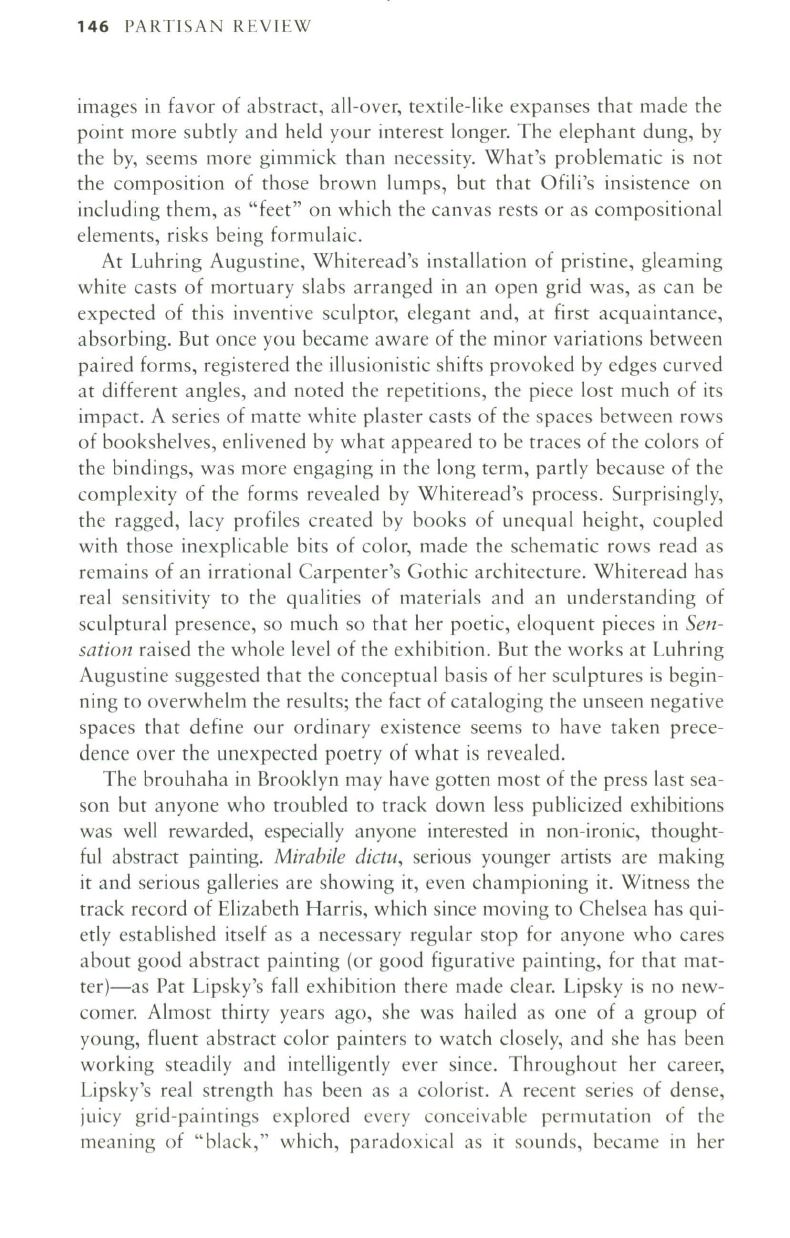
146
PARTISAN REVIEW
images in favor of abstract, all-over, textile-like expanses that made the
point more subtly and held your interest longer. The elephant dung, by
the by, seems more gimmick than necessity. What's problematic is not
the composition of those brown lumps, but that Ofili's insistence on
including them, as "feet" on which the canvas rests or as compositional
elements, risks being formulaic.
At Luhring Augustine, Whiteread's installation of pristine, gleaming
white casts of mortuary slabs arranged in an open grid was, as can be
expected of this inventive sculptor, elegant and, at first acquaintance,
absorbing. But once you became aware of the minor variations between
paired forms, registered the illusionistic shifts provoked by edges curved
at different angles, and noted the repetitions, the piece lost much of its
impact. A series of matte white plaster casts of the spaces between rows
of bookshelves, enlivened by what appeared to be traces of the colors of
the bindings, was more engaging in the long term, partly because of the
complexity of the forms revealed by Whiteread's process. Surprisingly,
the ragged, lacy profiles created by books of unequal height, coupled
with those inexplicable bits of color, made the schematic rows read as
remains of an irrational Carpenter's Gothic architecture. Whiteread has
real sensitivity to the qualities of materials and an understanding of
sculptural presence, so much so that her poetic, eloquent pieces in
Sen–
sation
raised the whole level of the exhibition. But the works at Luhring
Augustine suggested that the conceptual basis of her sculptures is begin–
ning to overwhelm the results; the fact of cataloging the unseen negative
spaces that define our ordinary existence seems to have taken prece–
dence over the unexpected poetry of what is revealed.
The brouhaha in Brooklyn may have gotten most of the press last sea–
son but anyone who troubled to track down less publicized exhibitions
was well rewarded, especially anyone interested in non-ironic, thought–
ful abstract painting.
Mirabile dictu,
serious younger artists are making
it and serious galleries are showing it, even championing it. Witness the
track record of Elizabeth Harris, which since moving to Chelsea has qui–
etly established itself as a necessary regular stop for anyone who cares
about good abstract painting (or good figurative painting, for that mat–
ter)-as Pat Lipsky's fall exhibition there made clear. Lipsky is no new–
comer. Almost thirty years ago, she was hailed as one of a group of
young, fluent abstract color painters to watch closely, and she has been
working steadily and intelligently ever since. Throughout her career,
Lipsky's real strength has been as a colorist. A recent series of dense,
juicy grid-paintings explored every conceivable permutation of the
meaning of "black," which, paradoxical as it sounds, became in her


